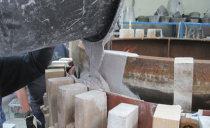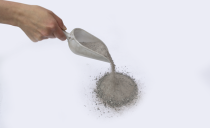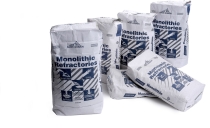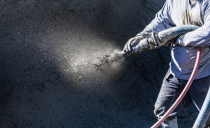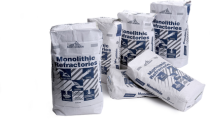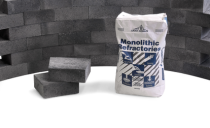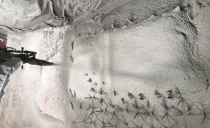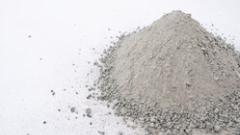
What are Monolithic Refractory Products?
Monolithic refractory products have an important role in many industries and processes because of their versatility and unique properties. By definition, they are unshaped refractory materials that can be engineered into any desired shape, which offers several advantages over traditional options. Some of the first monolithic refractories were used mixing refractory aggregates with lime and water, which led to the development of cement-bonded castables and other monolithic materials.
Monolithic refractory products primarily benefit various applications in cement plants, construction, ferrous and non-ferrous metallurgy, and petrochemical plants, as they are available in various forms and can be molded to suit specific requirements. This blog post provides an overview of monolithic refractory products, their properties, and key advantages.
Types of Monolithic Refractories and Implementation Methods
Monolithic refractories are available in several forms, each presenting unique properties and advantages. The forms include castables, dry vibrated cements, mortar, ramming and mixes for gunning and shotcreting implementation methods, which we will look at in more detail here.
Castables
These monolithic refractory materials are made of fine and coarse precision-graded refractory grains with a binder system. After being molded into specific shapes to suit a wide range of applications, the corresponding lining or samples are heated at high temperature. Castables are frequently used in furnaces, incinerators, and reactors, for glass and metal production molds, and more.
Dry Vibrated Cements
These monolithic refractory materials result from a high selection of pure grains and fines to be installed under vibration without any water addition. This complex system is based on mix phases transformation at different key temperatures all along the application process. The sintered material exhibits excellent resistance to corrosion and excellent dimensional stability leading to economy savings and more safety for the operators.
Mortar
Refractory mortar is used to join or repair bricks and tiles in extremely high-temperature applications. It is engineered with refractory powders, binders, and water to meet client requirements. Mortar, applied between bricks or tiles, is used to insure the joining to withstand the thermal expansion properties of the global masonry and to maintain a high resistance to corrosion by hot metals.
Ramming
Ramming is another method for applying monolithic materials. The process involves compacting the material into shape using a rammer, which helps the material compaction to get the suitable thermomechanical properties for the final application.
Shotcrete
Shotcrete is concrete or mortar used for rapid construction or repairs of bridges, buildings, storage reservoirs, and other constructions. It is mixed through the dry-mix or wet-mix process before it is applied with a high-velocity spray projected at the desired surface, reducing repair downtime and enhancing performance during melting operations.
Gunning
Gunning is a method used to apply monolithic materials for coating and repair purposes. The process involves spraying the desired material onto a component’s surface to form a coating, with thickness levels ranging from 10 to 30mm. Gunning materials are made from refractory aggregates, binders, and water and are used in high-temperature applications, such as metals and power generation industries.
Properties of Monolithic Refractories
Monolithic refractories have several properties that provide superior performance in a range of industrial applications. These properties include chemical inertness, high-temperature resistance, abrasion resistance, thermal shock resistance, and corrosion resistance.
● Chemical inertness: Meaning they do not react with corrosive or reactive materials.
● High-temperature resistance: They can withstand temperatures up to 1800°C (3272°F).
● Thermal shock resistance: Sudden temperature changes will not impact these materials.
These properties contribute to high durability and superior performance, making them ideal materials in high-temperature and harsh chemical environments. They can withstand mechanical wear and tear, will not corrode or rust when in contact with chemicals or other corrosive materials, and perform well under vacuum / pressure.
What are the Advantages of Monolithic Refractories?
Monolithic refractories provide many advantages over traditional materials, including ease of installation, joint-free linings, outstanding performance, and versatility in the industrial sectors.
Ease of Installation
Monolithic refractory materials are easier and quicker to install than refractory bricks, which reduces business owners' costs. They can be installed by casting, vibrating, cementing, gunning, or ramming methods, depending on the type of material being used.
Joint-free Linings
As these materials do not have any joints or seams, this significantly reduces the risk of corrosion and thermal shock. Another benefit to joint-free linings is that they are easier to clean, which saves time and money on maintenance.
Outstanding Performance
Monolithic refractories outperform traditional refractory bricks because of their abrasion, corrosion, and thermal shock resistance. These properties contribute to a longer and smoother operating life.
Versatility in Industrial Applications
Monolithic refractories have exceptional properties that enable them to withstand harsh chemical environments and high pressures and temperatures. This makes them suitable for a wide range of applications and industries.
Where Can I Purchase Monolithic Refractory Materials?
Saint-Gobain Performance Ceramics and Refractories offer a range of high-performing monolithic refractory materials for the most extreme operating conditions. Typically, we provide solutions for furnaces and kilns, metrology, ferrous and non-ferrous metals production, and many other demanding applications. Our product range includes castables, dry vibrated cement, mortar, patching, shotcrete, as well as gunning and ramming mixes.
Contact a team member now to learn more about monolithic refractory materials and their applications.
Related products
Castables
Saint-Gobain Performance Ceramics and Refractories' castables range is not limited to regular cement content but also specialties such as self-flowing or...
NORVIBE Dry Vibrated Cements (DVC)
NORVIBE™ dry vibrated cement mixes have been designed for ease of installation, outstanding service life and optimal metal corrosion resistance.
Mortar
Saint-Gobain Performance Ceramics & Refractories’ refractory mortar and cement mixes products have been developed to meet customer requirements.
Ramming
Saint-Gobain Performance Ceramics & Refractories’ range of wet and dry ramming mixes is adapted to accommodate a wide range of melting applications.
Shotcrete
Saint-Gobain Performance Ceramics & Refractories’ range of shotcrete mixes features optimized bonding systems to reduce rebound and enhance adhesion during...
Gunning
Saint-Gobain Performance Ceramics & Refractories’ a wide range of gunning mixes designed for furnace maintenance and repair.
Refrax® ProMor and PLUSflow - Mortar
Discover Saint-Gobain Performance Ceramics & Refractories’ Refrax® ProMor and PLUSflow mortars - the backbone of its tile systems for waste to energy...
Firefrax CRM-30 and Carbofrax Series - Mortars
Discover Saint-Gobain Performance Ceramics & Refractories’ comprehensive range of specialty mortars for copper furnaces.
Quick Repairs
Discover Saint-Gobain Performance Ceramics & Refractories’ range of versatile solutions for quick hot repairs.
